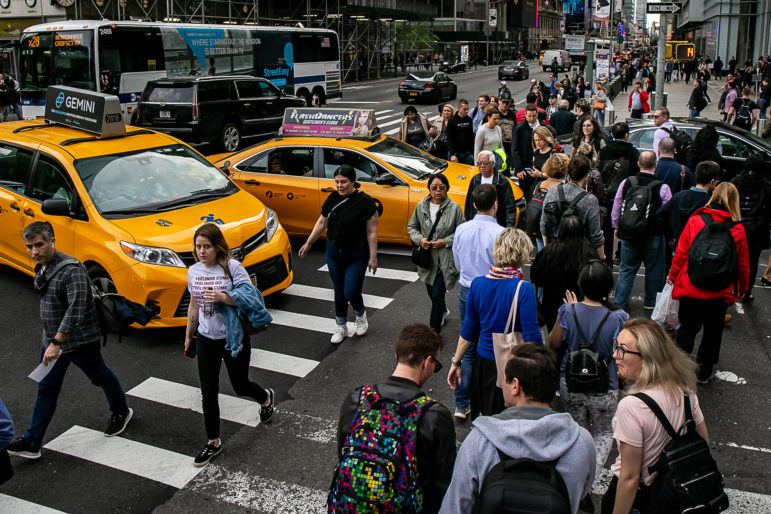‘We cannot repeat the mistakes of the past, where recoveries after the Great Recession, the Sept. 11 attacks, and the early 90s recession exacerbated systemic inequities rather than addressing them. And the people to determine a new direction cannot be the same people who benefit the most from the status quo.’

Adi Talwar
42nd Street and 6th Avenues in Manhattan.When the pandemic first started, one of the most noticeable things was the lines. But what the lines were for could be very different depending on one’s ZIP code.
Some parts of the city experienced long lines for COVID-19 testing; often neighborhoods with access to more resources. But certain neighborhoods—mostly low-income, mostly Black and brown, and largely immigrant communities—saw lines for food and emergency aid that lasted for months, and experienced lower testing rates even as they suffered disproportionately from the pandemic.
The lines, and what they were for, became one of the most noticeable signs of the racial inequality in New York City. As Yahshaanyah Hill, vice president of Workforce Opportunity Investments at the Upper Manhattan Empowerment Zone Development Corporation (UMEZ) noted, “The racial wealth gap has been long-standing—the pandemic just made its harmful reality easier for some to see.”
As we emerge from this pandemic, we know we need to grow our economy and bring opportunity back to New York. But it can’t be growth that helps those who need it the least while leaving out those who suffered the most. We cannot repeat the mistakes of the past, where recoveries after the Great Recession, the Sept. 11 attacks, and the early 90s recession exacerbated systemic inequities rather than addressing them. And the people to determine a new direction cannot be the same people who benefit the most from the status quo.
We need to be attuned directly with the New Yorkers working on the ground with vulnerable communities in organizations like UMEZ, which focuses on creating economic opportunities for their hyper-local community. We need new voices who are invested in building up their lives and communities through a just and shared recovery. We need people who represent the full diversity of the city—especially those within communities that have systematically been excluded from decision-making conversations. Inclusivity and equity must be more than a slogan. This vision must be backed up by a new process with better results.
 CityViews are readers’ opinions, not those of City Limits. Add your voice today!
CityViews are readers’ opinions, not those of City Limits. Add your voice today!
That is why the New York City Employment and Training Coalition (NYCETC), the Association for Neighborhood & Housing Development (ANHD) and Regional Plan Association (RPA) have combined resources to launch the NYC Inclusive Growth Initiative (IGI). IGI’s 18-person steering committee, which includes Hill, is bringing together New Yorkers with a variety of academic, professional, and lived experiences who can craft an agenda for real change for the city’s next elected officials.
Unfortunately, it is already clear that this recovery is not different, at least not yet. The essential workers who kept our city running are not gaining income, job security or career opportunities. Instead, they are facing stagnating wages, food insecurity, and an impending eviction crisis. The wealthiest Americans have gotten wealthier, while the situation for millions has grown even more precarious. Small businesses struggled to stay open and already, too many have shut their doors. And the rise in hate crimes against the AAPI community and the epidemic of police violence towards Black and brown New Yorkers highlight the continued threats, exclusion and intolerance in our city.
Our inequities become even clearer when New Yorkers are asked about their outlook on the region and their willingness to stay. A recent RPA/Global Strategy Group poll tracking attitudes and level of optimism in the New York metropolitan area showed that men scored 65 out of 100 while women were just 51 out of 100.
The numbers show even starker differences across races: 80 percent of Black respondents said they would like to move out of their community, compared to 43 percent of white respondents. Seventy-one percent of white respondents said they would encourage someone to move to New York City, while only 51 percent of people of color and 39 percent of Black respondents would. Black and Latinx New Yorkers are twice as likely to have lost a family member from COVID. Overall, women, Black, Latinx, and low-income respondents were less optimistic and less satisfied, while white men remained mostly positive about the city’s future.
Addressing this gap is not just a moral question. IGI’s Steering Committee knows what every New Yorker should now recognize: New York cannot and will not thrive if we do not provide inclusive, equitable opportunities for recovery by putting those that have been marginalized first, not last. We must go beyond platitudes and aspirations and make real changes that advance racial and economic justice and opportunity. It is time we start centering the tireless efforts and contributions of our everyday residents and make real changes that truly meet their needs and rise to this unprecedented moment in our lives.
Jose Ortiz, Jr. is the CEO of the New York City Employment and Training Coalition. Barika X. Williams is executive director at the Association for Neighborhood & Housing Development. Tom Wright is president and CEO of the Regional Plan Association.








